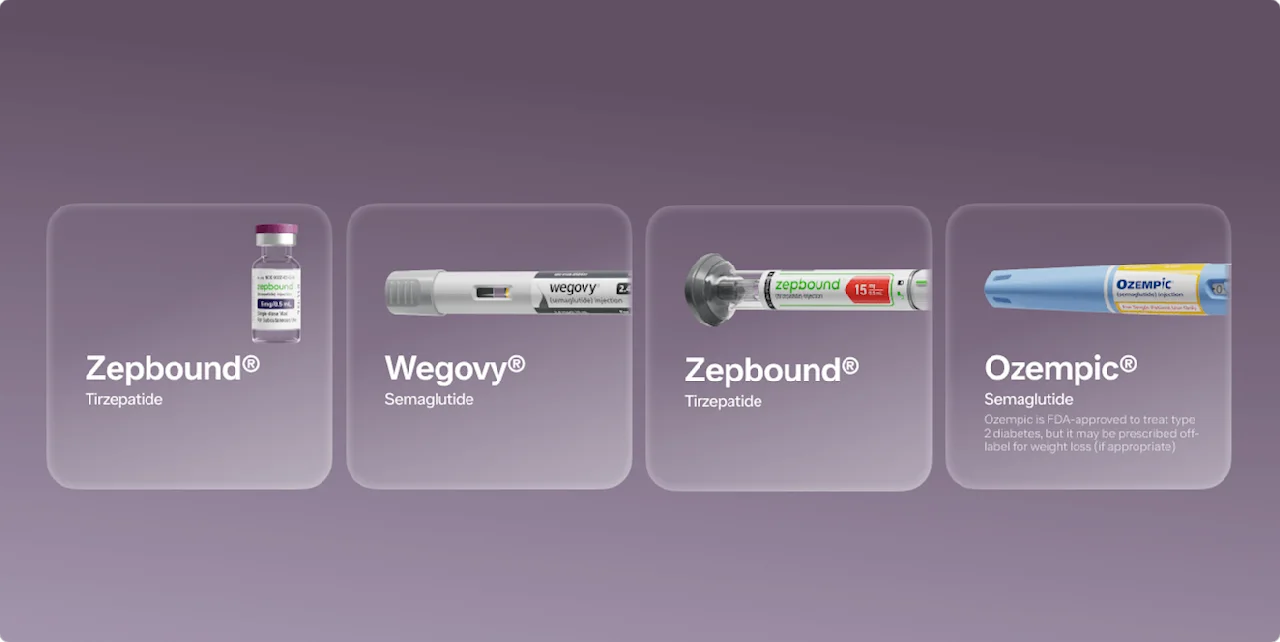Key takeaways
Farxiga (dapagliflozin) is a prescription medication that is FDA-approved to treat type 2 diabetes, chronic kidney disease (CKD), and heart failure. It may be prescribed off-label for weight loss.
On average, people taking Farxiga lose around 4–7 pounds. When combined with other medications, such as metformin, they may lose up to 10 pounds.
Possible side effects of Farxiga include dehydration, genital and urinary tract infections, cold-like symptoms, and back pain.
Here's what we'll cover
Here's what we'll cover
Key takeaways
Farxiga (dapagliflozin) is a prescription medication that is FDA-approved to treat type 2 diabetes, chronic kidney disease (CKD), and heart failure. It may be prescribed off-label for weight loss.
On average, people taking Farxiga lose around 4–7 pounds. When combined with other medications, such as metformin, they may lose up to 10 pounds.
Possible side effects of Farxiga include dehydration, genital and urinary tract infections, cold-like symptoms, and back pain.
Farxiga (dapagliflozin) is a prescription medication that is FDA-approved to treat type 2 diabetes, chronic kidney disease (CKD), and heart failure. Like other diabetes medications, such as Ozempic and metformin, Farxiga has also been shown to cause weight loss for some people.
But how many pounds can you actually expect to lose while taking Farxiga? And is this diabetes medication a good option for weight loss? Read on as we explain whether Farxiga works for weight loss, the risks and benefits, and more.
What is Farxiga?
Farxiga (dapagliflozin) is an FDA-approved prescription medication that, when combined with diet and exercise, can be used to treat type 2 diabetes by lowering blood sugar levels. It is also approved to reduce the risk of hospitalization or death in people with chronic kidney disease (CKD) and heart failure. Because Farxiga has been shown to promote weight loss in people with diabetes, it may be prescribed off-label for weight management.
Farxiga is a brand-name medication and there is no generic version yet available. Farxiga is an oral tablet that comes in two dosage strengths: 5 milligrams (mg) and 10 mg taken on a daily basis, with or without meals. Typically, health providers prescribe the 5 mg dosage strength to treat type 2 diabetes and the 10 mg dosage strength to treat CKD and heart failure. Depending on what it’s being used to treat, health providers may recommend combining Farxiga with other medications and lifestyle changes such as diet and exercise.
Dapagliflozin, the active ingredient in Farxiga, is also available in combination medications that treat diabetes, such as Qtern (dapagliflozin/saxagliptin) and Xigduo XR (dapagliflozin/metformin).
Does Farxiga cause weight loss?
Yes, Farxiga does cause weight loss, typically around 4–7 pounds. In one study of people with type 2 diabetes and heart disease, Farxiga led to an average weight loss of around 6 pounds within one year; however, some people may achieve weight loss of 5% or more while taking Farxiga.
While Farxiga causes weight loss, the results are less significant than other weight loss medications and even some diabetes medications, such as Ozempic. However, the amount of weight a person can lose on Farxiga can be significant enough to offer health benefits to people with type 2 diabetes and obesity. And, the research indicates that when Farxiga is combined with other diabetes drugs, the weight loss may be even more significant. For example:
When combined with glimepiride, Farxiga leads to a weight loss of 3–5 pounds.
When combined with metformin, Farxiga leads to a weight loss of 7–10 pounds. In one study, participants also reported ongoing improvements in their body weight, physical health, self-esteem, and overall quality of life at three separate checkpoints: six months, one year, and two years after starting treatment.
Ozempic Important Safety Information: Read more about serious warnings and safety info.
How does Farxiga cause weight loss?
Farxiga contributes to weight loss by reducing body fat, including belly fat around the waistline. In clinical studies of Farxiga, fat loss accounted for about two-thirds of participants’ total weight loss. Medications like Farxiga may also improve metabolism and help the body better process and even burn fat, further aiding in weight loss.
Farxiga belongs to a class of drugs known as sodium-glucose cotransporter 2 (SGLT2) inhibitors. SGLT2 inhibitors treat type 2 diabetes by blocking the amount of sugar absorbed by the kidneys and increasing the amount that leaves your body through your urine. This helps lower blood glucose levels, which is good for people with type 2 diabetes — but it’s also beneficial for those hoping to lose weight. When you have less glucose in your bloodstream, there is less available to be stored in the body. Farxiga removes about 75 grams of glucose from the bloodstream, which equates to roughly 300 calories.
While Farxiga primarily targets fat loss, it can lead to muscle loss as well, just like many other weight loss methods. To prevent losing muscle while taking Farxiga, talk to your healthcare provider about your options, such as increasing your protein intake and incorporating strength training into your routine. Building and maintaining muscle mass can not only boost your metabolism (leading to more sustained weight loss), but it can also improve muscle function, strength, mobility, and quality of life in general and for people with type 2 diabetes, obesity, and other health conditions.
How long does Farxiga take to work?
Weight loss begins soon after you start taking Farxiga. Typically, people notice a drop in their body weight within the first 2–4 weeks, a lot of which can be from lost water weight. Some people notice this drop in water weight as soon as day 3. Because Farxiga causes fluid loss, it can cause weight loss — but also dehydration. (When taking Farxiga, it’s more important to ensure you get enough fluids on a daily basis.)
After the initial loss of water weight on Farxiga, the weight loss continues but at a slower pace and affects body fat and lean muscle mass. In one study, individuals lost nearly 6 pounds within just 12 weeks of starting treatment, with roughly 4.5 pounds of those coming from body fat.
However, while the rate of weight loss may slow down, it continued at stable rates even six months after starting treatment, according to one study. This is important, researchers have noted, because typically, weight loss from lifestyle changes alone tends to plateau right around 6 months. In some cases, there can even be a reversal at that point, with unwelcome weight gain. Farxiga may help patients continue to lose weight thereafter.
When Farxiga is combined with other medications like metformin, patients may lose weight even faster. In clinical trials, people taking Farxiga and metformin lost nearly 6 pounds within three months, more than 9 pounds total within six months, and up to 10 pounds total after that.
Farxiga also starts working relatively quickly when treating other medical conditions. For example, when treating:
Type 2 diabetes: Farxiga starts to lower blood sugar levels within hours of your first dose. While this will have an immediate effect on your ability to manage your diabetes, it will take months before these changes register on your HbA1c levels since your HbA1c is a reflection of your blood sugar over three prior months.
Heart failure: People taking Farxiga reported fewer symptoms and hospitalizations, along with improved well-being within two weeks of starting treatment with Farxiga. These improvements were sustained at 1- and 2-year follow-ups.
Chronic kidney disease: The benefits of Farxiga can take longer to show up with CKD. In a study of people with CKD and/or diabetes, their likelihood of experiencing a reduction in kidney function, developing end-stage kidney disease, or dying from kidney or cardiovascular-related causes was significantly lower while taking Farxiga. These improvements were noticeable during the first year of the clinical trial and continued to improve over the next 2.4 years.
Is Farxiga safe?
Yes, Farxiga is a safe medication. But, like any prescription drug, it can cause side effects, some of which may be serious. Farxiga carries a greater risk for some people than others, including those who are older, pregnant or breastfeeding, or have kidney problems.
Common side effects of Farxiga
The most common side effects of Farxiga include (in order of frequency):
Genital infections
Cold-like symptoms
Back pain
Increased urination
Nausea
Flu
High cholesterol
Constipation
Discomfort while urinating
Pain in arms or legs
Both urinary tract infections (UTIs) and genital tract infections are more common with SGLT2 inhibitors like Farxiga. When taking Farxiga, women are more than twice as likely to develop a genital infection than men. People who have had genital infections before are also more likely to experience them when taking Farxiga.
Dehydration can also occur when taking Farxiga, as the medication makes you pee more often. People who are older, follow a low-salt diet, take water pills (diuretics), or have kidney issues may be more likely to experience dehydration when taking Farxiga. Signs of dehydration include feeling dizzy, faint, lightheaded, or weak, particularly when standing up. Be sure to drink plenty of liquids while taking Farxiga and ask your health provider for guidance regarding how much water you need to drink when using Farxiga.
Serious side effects of Farxiga
Serious side effects of Farxiga include:
Diabetic ketoacidosis, a life-threatening complication of diabetes
Volume depletion (low body sodium and water)
Urosepsis––a blood infection that can develop from the urinary tract
Pyelonephritis, a serious kidney infection
Hypoglycemia (low blood sugar)
Fournier’s Gangrene, a serious infection of the scrotum, penis, or perineum
Genital infections
An allergic reaction to Farxiga
Left untreated, these conditions can become serious and life-threatening. If you develop any of the following symptoms, contact your health provider immediately and stop taking Farxiga. It may be an early warning sign of a genital tract infection, diabetic ketoacidosis, or another potentially serious side effect of Farxiga.
Frequent, urgent, burning, or painful urination
Urine that smells or is cloudy, red, pink, or brown
Decrease in the amount of urine
Fever
Nausea or vomiting
Dry mouth or skin
Dark urine
Decreased sweating
Pain in the pelvis, rectum, or stomach
Feeling weak or tired
Shortness of breath
Rash, hives, or itching
Difficulty breathing or swallowing
Swelling of the face, throat, tongue, lips, mouth, or eyes
Hoarseness
Pain, tenderness, rash, or swelling in the genitals or perineum (the area of skin between your genitals and your anus)
Vaginal odor, itching, or abnormal discharge (lumpy, white, or yellow)
Rash, redness, itching, or swelling of the penis or surrounding skin
Foul-smelling discharge from the penis
Who should not take Farxiga?
Some people may be at increased risk of experiencing serious side effects when taking Farxiga, and some people should avoid taking Farxiga altogether. Farxiga is not recommended for children or people who:
Are pregnant or breastfeeding
Have type 1 diabetes
Have polycystic kidney disease
Have recently received immunosuppressive therapy to treat kidney disease
Have an estimated glomerular filtration rate (GFR, a measure of kidney function) below 45%
Have a known allergy to dapagliflozin or any of the inactive ingredients in Farxiga (microcrystalline cellulose, anhydrous lactose, crospovidone, silicon dioxide, magnesium stearate, polyvinyl alcohol, titanium dioxide, polyethylene glycol, talc, and yellow iron oxide)
Before taking Farxiga, it is important to tell your healthcare provider about your personal and family medical history and to give them a list of all the medications you take, including both prescription drugs and over-the-counter medicine, vitamins, and supplements. Also, be sure to tell your healthcare provider if you:
Binge drink or drink alcohol often
Are dieting or changing up what you eat
Plan on having surgery
In these scenarios, your healthcare provider may recommend adjusting your diet or drinking less while taking Farxiga, or they may have you stop taking Farxiga before undergoing surgery. They may also recommend a different medication that could be a better fit, given your health history and weight loss goals.
Farxiga can be an effective treatment for people with type 2 diabetes, kidney disease, and heart failure. It can also lead to some weight loss, usually up to 7 pounds, but sometimes more. If you’re wondering whether Farxiga could be a good option for you, make an appointment with your healthcare provider.
DISCLAIMER
If you have any medical questions or concerns, please talk to your healthcare provider. The articles on Health Guide are underpinned by peer-reviewed research and information drawn from medical societies and governmental agencies. However, they are not a substitute for professional medical advice, diagnosis, or treatment.
Brown, E., Wilding, J., Barber, T. M., et al. (2019). Weight loss variability with SGLT2 inhibitors and GLP‐1 receptor agonists in type 2 diabetes mellitus and obesity: Mechanistic possibilities. Obesity Reviews, 20(6), 816–828. doi:10.1111/obr.12841. Retrieved from https://onlinelibrary.wiley.com/doi/10.1111/obr.12841
Dhillon, S. (2019). Dapagliflozin: A review in Type 2 diabetes. Drugs, 79(10), 1135–1146. doi:10.1007/s40265-019-01148-3. Retrieved from https://link.springer.com/article/10.1007/s40265-019-01148-3
Ferreira-Hermosillo, A., Molina-Ayala, M. A., Molina-Guerrero, D., et al. (2020). Efficacy of the treatment with dapagliflozin and metformin compared to metformin monotherapy for weight loss in patients with class III obesity: a randomized controlled trial. Trials, 21(1), 186. doi:10.1186/s13063-020-4121-x. Retrieved from https://www.ncbi.nlm.nih.gov/pmc/articles/PMC7023779/
Grandy, S., Hashemi, M., Langkilde, A. M., et al. (2014). Changes in weight loss-related quality of life among type 2 diabetes mellitus patients treated with dapagliflozin. Diabetes, Obesity and Metabolism, 16(7), 645–650. doi:10.1111/dom.12263. Retrieved from https://dom-pubs.onlinelibrary.wiley.com/doi/abs/10.1111/dom.12263
Heerspink, H. J., Stefánsson, B. V., Correa–Rotter, R., et al. (2020). Dapagliflozin in Patients with Chronic Kidney Disease. The New England Journal of Medicine, 383(15), 1436–1446. doi:10.1056/nejmoa2024816. Retrieved from https://www.nejm.org/doi/full/10.1056/NEJMoa2024816
Iqbal, N., Ambery, P., Logue, J., et al. (2023). Perspectives in weight control in diabetes – SGLT2 inhibitors and GLP-1–glucagon dual agonism. Diabetes Research and Clinical Practice, 199, 110669. doi:10.1016/j.diabres.2023.110669. Retrieved from https://www.diabetesresearchclinicalpractice.com/article/S0168-8227(23)00430-8/fulltext
MedlinePlus. (2024). Dapagliflozin. Retrieved on Feb. 9, 2024 from https://medlineplus.gov/druginfo/meds/a614015.html
Nauck, M. A., Del Prato, S., Meier, J. J., et al. (2011). Dapagliflozin versus glipizide as add-on therapy in patients with type 2 diabetes who have inadequate glycemic control with metformin. Diabetes Care, 34(9), 2015–2022. doi:10.2337/dc11-0606. Retrieved from https://diabetesjournals.org/care/article/34/9/2015/38676/Dapagliflozin-Versus-Glipizide-as-Add-on-Therapy
Sargeant, J. A., Henson, J., King, J. A., et al. (2019). A Review of the Effects of Glucagon-Like Peptide-1 Receptor Agonists and Sodium-Glucose Cotransporter 2 Inhibitors on Lean Body Mass in Humans. Endocrinology and Metabolism (Seoul, Korea), 34(3), 247–262. doi:10.3803/EnM.2019.34.3.247. Retrieved from https://www.ncbi.nlm.nih.gov/pmc/articles/PMC6769337/
Schork, A., Saynisch, J., Vosseler, A., et al. (2019). Effect of SGLT2 inhibitors on body composition, fluid status and renin–angiotensin–aldosterone system in type 2 diabetes: a prospective study using bioimpedance spectroscopy. Cardiovascular Diabetology, 18(1). doi:10.1186/s12933-019-0852-y. Retrieved from https://cardiab.biomedcentral.com/articles/10.1186/s12933-019-0852-y
Strojek, K., Yoon, K., Hrubá, V., et al. (2014). Dapagliflozin Added to Glimepiride in Patients with Type 2 Diabetes Mellitus Sustains Glycemic Control and Weight Loss Over 48 Weeks: A Randomized, Double-Blind, Parallel-Group, Placebo-Controlled Trial. Diabetes Therapy, 5(1), 267–283. doi:10.1007/s13300-014-0072-0. Retrieved from https://link.springer.com/article/10.1007/s13300-014-0072-0
U.S. Food and Drug Administration (FDA). (2023). Farxiga (dapagliflozin) tablets, for oral use. Retrieved on Feb. 8, 2024 from https://www.accessdata.fda.gov/drugsatfda_docs/label/2023/202293s026lbl.pdf
Vaduganathan, M., Claggett, B., Jhund, P. S., et al. (2022). Time to clinical benefit of dapagliflozin in patients with heart failure with mildly reduced or preserved ejection fraction. JAMA Cardiology, 7(12), 1259. doi:10.1001/jamacardio.2022.3750. Retrieved from https://jamanetwork.com/journals/jamacardiology/fullarticle/2796867
Vasilakou, D., Karagiannis, T., Athanasiadou, E., et al. (2013). Sodium–Glucose cotransporter 2 inhibitors for type 2 diabetes. Annals of Internal Medicine, 159(4), 262. doi:10.7326/0003-4819-159-4-201308200-00007. Retrieved from https://www.acpjournals.org/doi/10.7326/0003-4819-159-4-201308200-00007
Wilding, J., Bailey, C., Rigney, U., et al. (2016). Glycated Hemoglobin, Body Weight and Blood Pressure in Type 2 Diabetes Patients Initiating Dapagliflozin Treatment in Primary Care: A Retrospective Study. Diabetes Therapy: Research, Treatment and Education of Diabetes and Related Disorders, 7(4), 695–711. doi:10.1007/s13300-016-0193-8. Retrieved from https://www.ncbi.nlm.nih.gov/pmc/articles/PMC5118232/
Williams, D. M., Nawaz, A., & Evans, M. (2020). Drug therapy in Obesity: A review of current and emerging treatments. Diabetes Therapy, 11(6), 1199–1216. doi:10.1007/s13300-020-00816-y. Retrieved from https://link.springer.com/article/10.1007/s13300-020-00816-y
Wolf, V. L. W., Breder, Í., De Carvalho, L. S. F., et al. (2021). Dapagliflozin increases the lean-to total mass ratio in type 2 diabetes mellitus. Nutrition & Diabetes, 11(1). doi:10.1038/s41387-021-00160-5. Retrieved from https://www.nature.com/articles/s41387-021-00160-5











